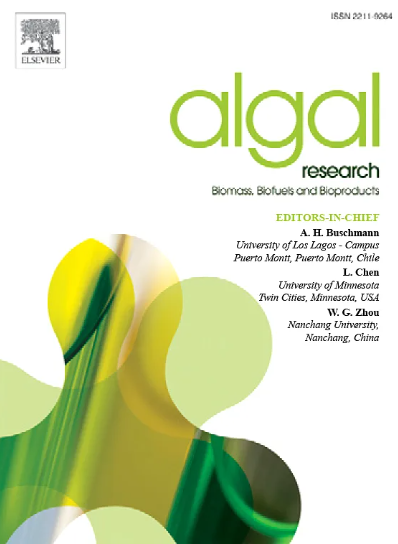Comparison of CRISPR/Cas9 and Cas12a for gene editing in Chlamydomonas reinhardtii
IF 4.6
2区 生物学
Q1 BIOTECHNOLOGY & APPLIED MICROBIOLOGY
Algal Research-Biomass Biofuels and Bioproducts
Pub Date : 2024-11-12
DOI:10.1016/j.algal.2024.103796
引用次数: 0
Abstract
CRISPR/Cas-based technologies have revolutionized biology, offering a wide range of gene editing and engineering applications due to their diverse enzyme characteristics. Among the CRISPR/Cas nucleases, Cas9, and more recently, Cas12a (formerly known as Cpf1), have been employed in various gene editing applications in many eukaryotes, including the model green alga Chlamydomonas reinhardtii. To provide a comprehensive picture of their applicability in single-strand templated DNA repair and gene editing, we first mapped their targeting space by analysing their corresponding PAM frequencies, and then compared Cas9 and Cas12a activities by targeting overlapping regions at three independent loci in the Chlamydomonas genome. We identified 8 and 32 times more target sites for Cas9 compared to Cas12a within promoter regions and coding sequences, respectively. We found that Cas9 and Cas12a RNPs- co-delivered with ssODN repair templates- induced similar levels of total editing, achieving as much as 20–30 % in all viably recovered cells. Importantly, the level of precision editing was slightly higher for Cas12a. In contrast, Cas9 alone was able to induce more edits at the FKB12 locus than its Cas12a counterpart, overall making Cas9 the preferable enzyme for genome engineering among the currently available nucleases in C. reinhardtii.
比较 CRISPR/Cas9 和 Cas12a 在衣藻中的基因编辑作用
基于CRISPR/Cas的技术给生物学带来了革命性的变化,由于其具有多种酶的特性,因此可以提供广泛的基因编辑和工程应用。在 CRISPR/Cas 核酸酶中,Cas9 和最近的 Cas12a(以前称为 Cpf1)已被用于许多真核生物(包括模式绿藻衣藻)的各种基因编辑应用中。为了全面了解它们在单链模板 DNA 修复和基因编辑中的适用性,我们首先通过分析它们相应的 PAM 频率绘制了它们的靶向空间图,然后通过在衣藻基因组中三个独立位点上靶向重叠区域比较了 Cas9 和 Cas12a 的活性。我们发现在启动子区域和编码序列中,Cas9 的靶位点分别是 Cas12a 的 8 倍和 32 倍。我们发现,Cas9 和 Cas12a RNPs(与 ssODN 修复模板共同传递)诱导的总编辑水平相似,在所有可存活的恢复细胞中都达到了 20-30% 的水平。重要的是,Cas12a 的精确编辑水平略高。相比之下,单独使用 Cas9 在 FKB12 基因座上诱导的编辑比使用 Cas12a 诱导的编辑更多,总体而言,Cas9 是目前可用的 C. reinhardtii 核酸酶中最适合用于基因组工程的酶。
本文章由计算机程序翻译,如有差异,请以英文原文为准。
求助全文
约1分钟内获得全文
求助全文
来源期刊

Algal Research-Biomass Biofuels and Bioproducts
BIOTECHNOLOGY & APPLIED MICROBIOLOGY-
CiteScore
9.40
自引率
7.80%
发文量
332
期刊介绍:
Algal Research is an international phycology journal covering all areas of emerging technologies in algae biology, biomass production, cultivation, harvesting, extraction, bioproducts, biorefinery, engineering, and econometrics. Algae is defined to include cyanobacteria, microalgae, and protists and symbionts of interest in biotechnology. The journal publishes original research and reviews for the following scope: algal biology, including but not exclusive to: phylogeny, biodiversity, molecular traits, metabolic regulation, and genetic engineering, algal cultivation, e.g. phototrophic systems, heterotrophic systems, and mixotrophic systems, algal harvesting and extraction systems, biotechnology to convert algal biomass and components into biofuels and bioproducts, e.g., nutraceuticals, pharmaceuticals, animal feed, plastics, etc. algal products and their economic assessment
 求助内容:
求助内容: 应助结果提醒方式:
应助结果提醒方式:


